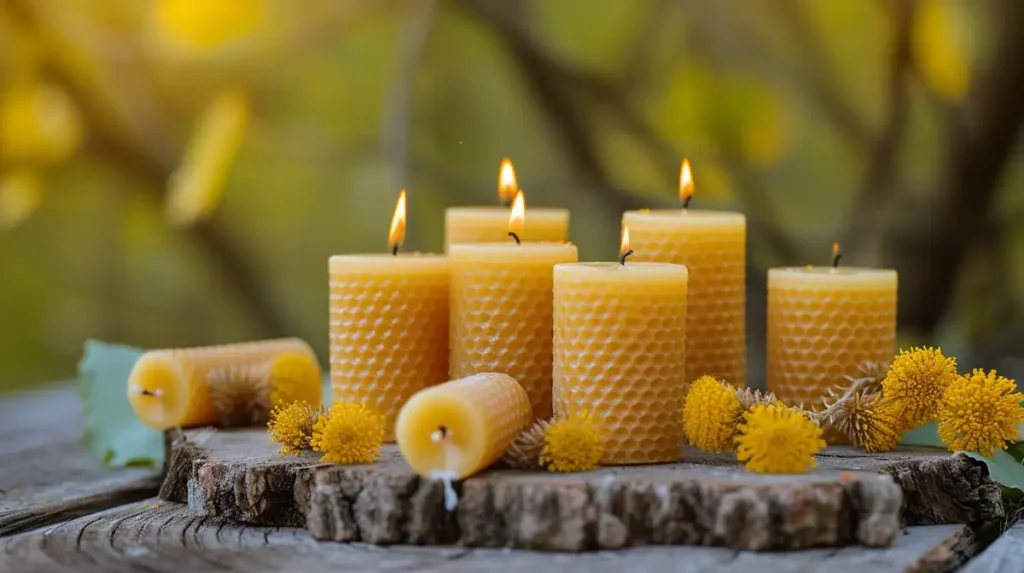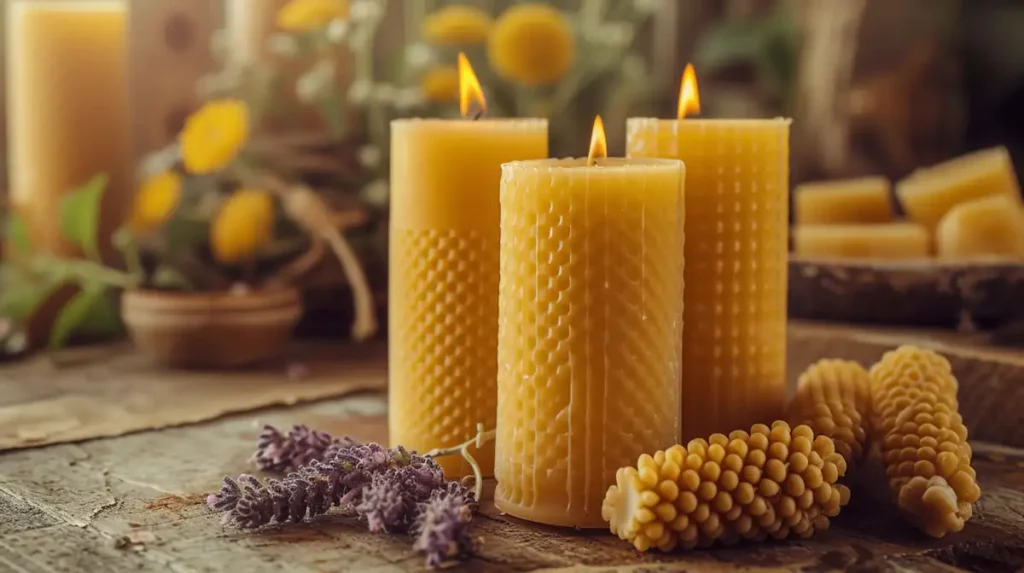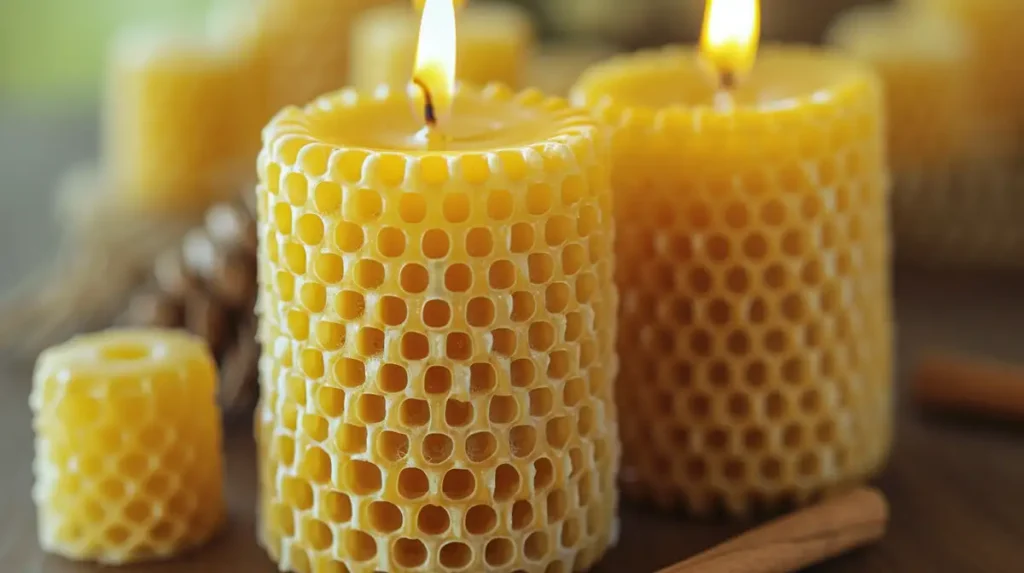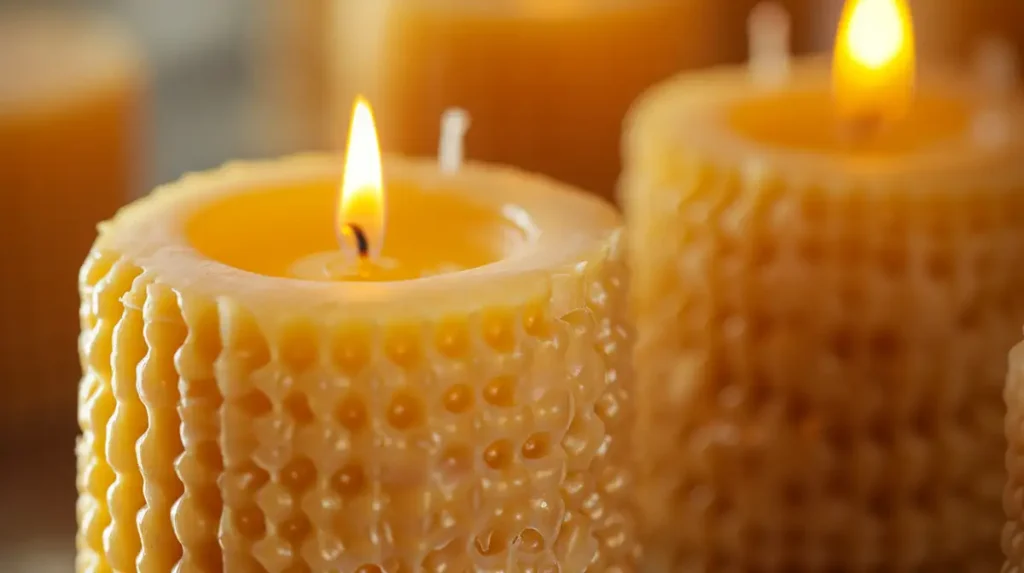Table of Contents
Candles have been a staple of human culture and tradition for centuries. During that time, they have served various purposes ranging from religious ceremonies to home decor. In recent times though, there has been an increasing demand for natural and sustainable products. This has led to the current popularity of beeswax candles. Being of natural ingredients, beeswax candles are known for their long burn times and pleasant aromas. This makes them a favorite with many people. If you are a beekeeper, you can create natural beeswax candles using wax from your hive. In this article, I will take a deep dive into the intricacies of making beeswax candles, hopefully guiding you from start to finish.
The Benefits of Beeswax Candles
The advantages of beeswax candles are numerous when compared to conventional candles made from paraffin wax. The following benefits are associated with using beeswax candles:
- 100% natural – Beeswax is a natural and sustainable material. This sets it apart from paraffin wax, which is derived from petroleum.
- Long burn time – These candles have a more prolonged burn time when compared to regular candles. This makes them more durable.
- Clean burning – Beeswax candles are thought to emit negative ions when burned, which can help to purify the air by removing pollutants. (This is still a topic of debate though. As far as I know, there is no know scientific research into the topic.)
- Aromatherapy – The candles have a natural honey scent that is both soothing and calming to the senses.
- Non-toxic – These candles are non-toxic, which is unlike paraffin wax candles that can release harmful chemicals when burned.
The Importance of Using Natural Beeswax
It is vital to use natural beeswax when making candles. Many candles on the market purport to be made from beeswax but may contain other ingredients such as paraffin wax, soy wax, or palm wax. These additional components can reduce the quality of the candle, causing it to burn faster and impacting the scent. By utilizing the natural beeswax from your hive, you will ensure that you are getting a premium, pure product.
Obtaining Beeswax from Your Hive
To make the candles, you obviously need to have beeswax. Here are the steps to take to acquire beeswax from your hive (if you have one):
- Collecting honey – The first step is to harvest honey from the hive, which is the primary source of beeswax. When you extract honey from the combs, you will also remove beeswax.
- Filtering the wax – After you’ve collected the honey, filter the beeswax to remove any impurities. You can use a cheesecloth or a fine-mesh strainer to filter the wax.
- Melting the wax – The filtered beeswax will need to be melted down before you can use it to make the candles. Do this by using a double boiler, an oven, or even a slow cooker.
Preparation
Before making the candles, it is important to prepare the workspace and gather all the necessary equipment. Here is a list of what you’ll need:
Equipment
- Beeswax – The amount of beeswax required will depend on the size of candles you want to make.
- Wick – Choose a wick that you think will be suitable for the size of the candle you plan to create. These can be obtained from craft stores or a multitude of places online.
- Candle molds – You can use any heat-resistant mold. Metal and silicone molds are two examples.
- Double boiler – You will need a double boiler to melt the beeswax; alternatively, a slow cooker or oven will work as well.
- Essential oils – If you want to add a scent to the candles, select essential oils that are safe to use.
- Colorants – Natural colorants such as various herbs or spices can be added to the beeswax for coloring.
Safety Precautions
It is important to be safe when working with beeswax to avoid burns and the potential for fire. Here are a few safety tips to keep in mind:
- Use heat-resistant gloves to protect your hands from hot wax.
- Work in a well-ventilated area to avoid inhaling wax fumes.
- Never leave the melting wax unattended.
- Keep a fire extinguisher nearby, just in case of an emergency.
- Don’t pour hot wax down the sink or drain. Doing so could cause blockages.

Melting the Beeswax
After setting up your equipment and taking the safety precautions into account, it is time to start melting the beeswax. Below are three methods of doing this:
Double Boiler Method
The double boiler method is the safest and most common way of melting beeswax. Here’s how it is done:
- Fill a large pot with water and bring it to a boil.
- Place a smaller pot or bowl on top of the larger pot.
- Add the beeswax to the smaller pot or bowl and stir occasionally until it melts.
Oven Method
The oven method is useful when it comes to melting a lot of beeswax. The best way to do it is:
- Preheat the oven to 200 degrees Fahrenheit.
- Place the beeswax in a heat-resistant container and place it in the oven.
- Stir occasionally until the beeswax melts.
Slow Cooker Method
The slow cooker method is the most convenient of all three methods, but it does take the longest to melt the beeswax. Do it by:
- Filling the slow cooker with water and setting it to a low heat.
- Adding the beeswax to a heat-resistant container and placing it into the slow cooker.
- Stirring occasionally until the beeswax melts.
Enhancing Your Candles with Scents and Colors
After melting the beeswax, you can add scents and colors to it to make the end candles more appealing. Here is how you can do this:
Choosing Natural Scents
To ensure that the candles are safe for use, it is recommended to use only natural essential oils for scents. Some popular natural scent choices to consider are:
- Carter, Anthony (Author)
- English (Publication Language)
- 194 Pages - 02/28/2024 (Publication Date) - Independently published (Publisher)
- Lavender – Soothing and calming
- Peppermint – Energizing and refreshing
- Lemon – Clean and fresh
- Vanilla – Comforting and warm
Adding the Essential Oils
Add the oils to the beeswax candles and mix them in before pouring it into the molds. Here is what to do:
- Add 10-20 drops of essential oil per pound of beeswax.
- Thoroughly stir the essential oil into the melted beeswax.
Adding Natural Colors
If you want to add some color to the candles, use natural colorants like herbs or spices. The below are just some of the options to consider:
- Turmeric – Yellow
- Beetroot powder – Pink or red
- Spirulina – Green
To add color to the beeswax, mix the colorant into the melted wax before pouring into the molds. Start with a small amount and adjust as needed to achieve the desired color.
Preparing the Wicks
Before pouring the beeswax into the molds though, you will need to prepare the wicks:
Selecting the Right Wick
Choosing an appropriate wick size is crucial as this will affect the eventual candle’s burn rate. You will need to:
- use a thin wick for small candles
- use a thicker wick for large candles
Preparing Wicks for Use
After choosing the appropriate wick size, you will need to prepare it for use. Follow these steps:
- Cut the wick to the length of your candle mold, adding a few extra inches.
- Dip the wick into the melted beeswax and remove it.
- Allow the wick to cool and harden by placing it on a flat surface.
Securing Wicks in the Mold
To hold the wick in place in the mold, use a wick holder or a pencil. Here’s how:
- Thread the wick through the wick holder or tie it to a pencil.
- Place the wick holder or pencil on top of the mold.
- Center the wick in the mold and hold it in place using the wick holder or pencil.

How to Pour Beeswax for Candle Making
Once you have prepared the wicks, the next thing to do is pour the melted beeswax into the molds. I explain how in the below paragraphs:
Choosing the Right Mold
As mentioned above, you can use any mold that can withstand heat to make your beeswax candles. The most common options are metal and silicone molds. To that end, here are some popular types of molds that you can use:
- Pillar molds – great for making tall candles
- Tea light molds – better for smaller candles
- Votive molds – probably the best for medium-sized candles
Pouring the Beeswax
To pour the beeswax into the molds, follow these steps:
- Place the molds on a flat surface.
- Gently pour the melted beeswax into the molds, leaving about 1/4 inch of space at the top.
- Let the beeswax cool and harden for a few hours.
Adding Multiple Layers
If you want to add multiple layers of beeswax to the candles, wait until the first layer has hardened before pouring the next layer. Repeat the process until you’ve achieved the desired height.
Finishing and Storing
Once the beeswax candles have hardened, you can trim the wick and clean the molds. Here’s the procedure:
Trimming the Wick
To trim the wick, follow these steps:
- Use sharp scissors or a wick trimmer to cut the wick to 1/4 inch.
- Discard the trimmed wick.
Cleaning the Mold
To clean the mold, follow these steps:
- Remove any leftover beeswax from the mold.
- Wash the mold with warm, soapy water, and then dry it.
Storing the Finished Candles
Store the finished beeswax candles in a cool, dry place away from direct sunlight. To prevent the candles from sticking together, wrap them in tissue paper or store them in individual containers.

How to Make Natural Beeswax Candles – Conclusion
Making your own beeswax candles is a fulfilling and enjoyable activity that lets you create high-quality, natural candles using materials from your own beehive. By following the steps that have been outlined in this article, you can make candles that are safe, eco-friendly, and free from harmful chemicals. So why not give it a try? You might just discover a new hobby that you’ll love!
FAQs
Q: What are the main ingredients needed to make natural beeswax candles?
A: The main ingredients needed to make natural beeswax candles are pure beeswax, a suitable wick (such as cotton or hemp), and a heat source for melting the beeswax.
Q: How do I choose the right type of beeswax for making candles?
A: Look for 100% pure, natural beeswax, preferably from a local source. It should have a golden-yellow color, a pleasant honey-like aroma, and be free from additives or chemicals.
Q: What type of wick is best for beeswax candles?
A: A braided cotton or hemp wick works well with beeswax candles. Choose a wick with a suitable thickness for the diameter of your candle. As a general rule, the larger the candle, the thicker the wick should be.
Q: How do I prepare the wick for my beeswax candle?
A: To prepare the wick, cut it to the desired length, adding a few extra inches for the knot at the bottom and the excess at the top. Dip the wick in melted beeswax and let it cool, straightening it as it dries. This process is called “priming” and helps the wick burn more evenly.
Q: How can I melt beeswax safely?
A: Melt beeswax using a double boiler or a heatproof container placed in a pot of simmering water. Never melt beeswax directly on a heat source, as it can overheat and become flammable. Monitor the temperature with a thermometer, keeping it below 185°F (85°C) to prevent discoloration or loss of aroma.
Q: How do I pour the melted beeswax into a candle mold or container?
A: Slowly and carefully pour the melted beeswax into your chosen mold or container, leaving a small gap at the top for the wick. To keep the wick centered, use a wick holder or a pencil to suspend the wick in the middle of the container until the wax cools and solidifies.
Q: How long does it take for beeswax candles to harden?
A: The time it takes for beeswax candles to harden depends on the size and shape of the candle. Smaller candles may harden within a few hours, while larger candles may take up to 24 hours. It’s best to let the candles cool and harden at room temperature.
Q: How can I add natural scents to my beeswax candles?
A: To add natural scents, use essential oils derived from plants, flowers, or herbs. Add a few drops of your chosen essential oil to the melted beeswax before pouring it into the mold or container. Be cautious with the amount, as too much essential oil can negatively affect the burning quality of the candle.
Q: Can I use natural dyes to color my beeswax candles?
A: Yes, you can use natural dyes to color your beeswax candles. Some options include using plant-based dyes or powdered pigments derived from natural sources. Keep in mind that adding too much dye can affect the candle’s burning properties.
Q: How can I store my beeswax candles?
A: Store your beeswax candles in a cool, dry place away from direct sunlight or heat sources. Keep them wrapped in parchment paper or stored in an airtight container to preserve their aroma and appearance.
Q: How do I choose the right mold for making beeswax candles?
A: You can use various types of molds, including silicone, metal, or plastic, to make beeswax candles. Choose a mold based on the desired shape and size of your candle, ensuring it can withstand the heat of the melted beeswax without deforming or melting.
Q: Can I make beeswax candles without a mold?
A: Yes, you can make beeswax candles without a mold by using beeswax sheets. Cut the beeswax sheet to the desired size, place the primed wick at one end, and roll the sheet tightly around the wick. Press the edge gently to seal the candle.
Q: Why are there bubbles in my finished beeswax candles?
A: Bubbles can form if the melted beeswax is poured too quickly, if the mold or container is not pre-warmed, or if the beeswax cools too rapidly. To minimize bubbles, pour the beeswax slowly, pre-warm the mold or container, and allow the candle to cool gradually at room temperature.
Q: Can I make layered beeswax candles with different colors or scents?
A: Yes, you can create layered beeswax candles by pouring individual layers of differently colored or scented beeswax one at a time. Allow each layer to harden partially before pouring the next layer to prevent mixing or blending of colors and scents.
Q: How do I clean my candle molds after making beeswax candles?
A: To clean your candle molds, gently scrape out any remaining wax with a soft, non-abrasive tool, such as a silicone spatula. If necessary, warm the mold slightly to soften the wax. Then, wash the mold with warm, soapy water and dry it thoroughly before storing or using it again.
Q: How can I fix a tunneling beeswax candle?
A: To fix a tunneling beeswax candle, use a heat gun or hairdryer to carefully melt the top layer of wax around the wick, allowing the excess wax to fill the tunnel. Be cautious not to overheat or burn the wick. Trim the wick to approximately 1/4 inch (6mm) before lighting the candle again.
Q: Can I reuse leftover beeswax from burned candles or wax spills?
A: Yes, you can collect and reuse leftover beeswax from burned candles or wax spills. Gently melt the leftover beeswax in a double boiler, strain it through a fine mesh sieve or cheesecloth to remove impurities, and then use it to make new candles.
Q: How do I know when my beeswax candle is ready to burn?
A: Your beeswax candle is ready to burn once it has fully cooled and hardened, and the wick has been trimmed to the proper length. Before burning, ensure that the candle is placed on a heat-resistant surface and away from flammable materials, drafts, or direct sunlight.
Last update on 2024-04-25 / Affiliate links / Images from Amazon Product Advertising API


